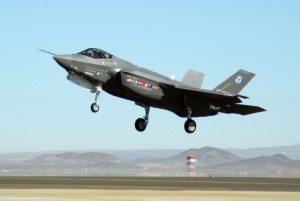By Kimbal Cariou, rabble.ca, April 1, 2011
Last June, I wrote an article for the Georgia Straight in B.C. about the skyrocketing costs of purchasing new F-35 Joint Strike Fighter jets from U.S. munitions giant Lockheed Martin.
At the time, the news had just broken that the price tag had jumped from $3.8 billion for 80 F-35s when the deal was first proposed back in 2008, up to $9 billion for just 65 jets, plus another $7 billion on “ancillary costs” such as future parts and maintenance. The total price tag had more than quadrupled within just two years! Now we understand from Pentagon figures that the total cost of this purchase over a 30-year period is expected to hit $29 billion, a staggering sum for a country with serious social and economic problems.
Just three years ago, the individual jets were priced at $47.4 million each. Now the price for each jet, plus parts and maintenance, has jumped over $400 million, at a time when the Harper Conservatives are slashing social program spending.
And it gets worse. The original plan by the Conservatives was to replace the Canadian Forces’ current fleet of CF-18 fighter jets. Since then, $2.6 billion has been spent to upgrade the CF-18s.
A Commons committee has investigated the purchase of the new fighters, including the price tag and whether Canada actually needs these weapons. Eyebrows were quickly raised over the news that there would be no other bids for the contract. Another controversy has focused on the fact that the F-35 Joint Strike Fighter is a single-engine aircraft, unsuitable to patrol the Canadian Arctic. (The CF-18s have two engines, which many pilots consider an important safety feature.)
But the NATO war against Libya has raised even more serious issues over this massive boondoggle. With its payload of heavy armament, the F-35s are useful for only one purpose: to engage in modern warfare, bombing “enemy” nations.
A year ago, a survey conducted by Leger Marketing asked “With Canada’s military role ending in Afghanistan next year, what should the focus be on the government’s military spending?” Almost 60 per cent agreed with this answer: “Canada should take a peace dividend and cut back on military spending to focus on other more pressing social issues at home.” Only 28 per cent of respondents wanted to “sustain or increase spending on the military because security in a post-9/11 world is of the highest priority”.
Yet according to the Canadian Centre for Policy Alternatives, “the Canada First Defence Strategy, unveiled by the Harper government in 2008, promises that Canada’s military spending will continue to grow by an average of 0.6% in real terms (adjusted for inflation) and an average of 2.7% in nominal terms (not adjusted for inflation) per year from FY 2007-08 to 2027-28.”
Total spending over the 20-year life of this plan would likely be in the $415-440 billion range (2009 dollars), or about $13,000 per Canadian, surely enough to cause us to rethink the quaint notion that this country’s military spending is negligible.
Imagine what could be done with the $29 billion in savings by scrapping the F-35 deal! To give just a few examples, the public transportation systems of Canadian cities could be provided with 10,000 fuel-efficient new buses for just $5 billion.


